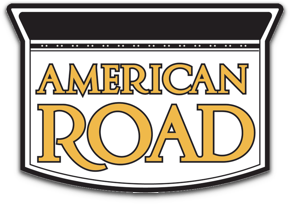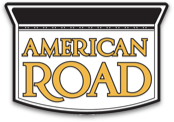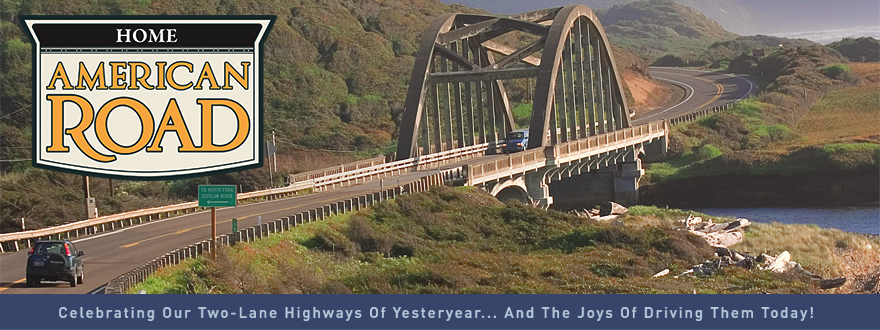-
Posts
1,247 -
Joined
-
Last visited
-
Days Won
1
Content Type
Profiles
Forums
Gallery
Blogs
Calendar
Everything posted by mobilene
-
I mentioned earlier in this thread that a fellow I know in Champaign, IL, mentioned to me the one-lane concrete road network in his county. Here he posts to his blog a photo of one of those roads, now widened to include a second asphalt lane. http://pesoto74.wordpress.com/2010/03/24/hard-roads/
-
One last post from this section of the Dixie, from the town square in Paoli. http://blog.jimgrey.net/2012/11/26/on-paolis-square/
-
I have learned that there are just times when you gather the best info you have and then let your gut take you the rest of the way. I did a little of that when laying out the route that we got approved to be the Historic Michigan Road Byway in Indiana -- there are a couple places where the road's original route just wasn't 100% explained by available resources, and so I made my best educated guess and off we went!
-
Thanks guys. Isn't the sleuthing, trying to find where the road used to go, just the most fun part of all this? Alex, you'd better believe they buried the original concrete under asphalt on the old DH in southern IN. Check this photo I took a few years ago along an abandoned section. A bridge was removed, revealing this 1925 concrete covered in three layers of asphalt: Abandoned SR 37 by mobilene, on Flickr
-
The puzzle of old alignments in Bedford is solved! Be sure to read all the comments on this one, too: http://blog.jimgrey.net/2012/11/16/revisiting-bedford/
-
I said I'd post as I updated my blog with stories from my October Indiana Dixie Highway trip, but I've been remiss. So here's everything I've written so far. I have two or three more stories to tell, so watch this space - I'll add links to those as they appear on my blog. Introduction: http://blog.jimgrey.net/2012/10/22/driving-the-dixie-highway-in-southern-indiana/ A 1925 bridge and some concrete pavement from no later than that year: http://blog.jimgrey.net/2012/10/26/old-road-archaeology/ Beautiful fall color on a winding old alignment: http://blog.jimgrey.net/2012/10/31/the-winding-road-to-bloomington/ Scenes from Bloomington: http://blog.jimgrey.net/2012/11/07/the-courthouse-in-bloomington/ Abandoned section near Oolitic: http://blog.jimgrey.net/2012/11/12/abandoned-dixie-highway-at-oolitic/ -Jim
-
Your car, sir, is what we like to call a "survivor," and in some ways that's better than one well restored. It bears the marks of its use. It makes it more authentic. Please keep us updated on your progress toward hitting the road. And when you pass through Ohio and Indiana, I strongly recommend the National Road, better known today as US 40. There are several great old alignments, too, some of them brick and concrete laid almost 100 years ago, if you're into that sort of thing. -Jim
-
More from the road: http://blog.jimgrey.net/2012/10/31/the-winding-road-to-bloomington/
-
First two blog posts are up: http://blog.jimgrey.net/2012/10/22/driving-the-dixie-highway-in-southern-indiana/ http://blog.jimgrey.net/2012/10/26/old-road-archaeology/
-
That's a great rule of thumb to have in my hip pocket, Dave. I do run across concrete in my travels from time to time (as recently discussed elsewhere on this board). -Jim
-
Someone who reads my blog lives in the Champaign area, which is a bit south of where you were. He once commented that there was a push in the 1920s to connect all the towns in that county with one-lane concrete slabs, but that as far as he knows the last of them were paved over in the 1970s. Maybe you came upon a similar road in that area. Maybe this was an eastern Illinois thing. This fellow said that for some years, an asphalt lane was paired alongside the concrete lane -- but that everyone drove on the concrete regardless of the direction they traveled, and the wrong-way drivers moved onto the asphalt only when they encountered another car! -Jim
-
If you'd like to see some of that old Martinsville brick, click here: http://goo.gl/maps/lbQ88 This is actually on an old alignment of what became State Road 39 on the west side of town, but it just has to be from the same time as the brick laid on the Dixie. -Jim
-
Dave, That explains the black road in and out of Martinsville on the 1923 map! Great sleuthing! Thanks for doing it. -Jim
-
Dave, I hope I didn't muddy the waters. But as I read the 1923 map, the road was gravel or stone, except for a short paved section leading away from Martinsville. Am I misreading it? In 1917, the road wasn't yet part of the Indiana highway system, so if it was concreted before then the counties had to do it. That strikes me as unlikely, though obviously not impossible. -Jim
-
Cool! I looked it up in Street View just now. I wouldn't have guessed it was a garage back in the day. If this concrete dates to 1916, my mind would officially boggle! That would have to be about the earliest concrete poured on an Indiana highway. But I remembered this morning the cache of state highway maps online at Indiana University. The Indiana Dept. of Highways wasn't born until 1917. Here's a 1917 map of the fledgling state highway system: http://bl-libg-doghill.ads.iu.edu/gm-web/imdb/inhwy1917.jpg Notice that State Road 22 (which was this road's number on the original numbering system) doesn't appear on it; the system had but five highways then. By 1923, the system had expanded to include this portion of the DH. In this 1923 Dept. of Highways map, it is marked as stone/gravel. http://bl-libg-doghill.ads.iu.edu/gm-web/imdb/inhwy1923.pdf The 1924 map shows stone/gravel too. The 1927 map (1925 and 1926 are not available, unfortunately -- key years to be missing) shows it as paved. http://bl-libg-doghill.ads.iu.edu/gm-web/imdb/inhwy1927.pdf So one thing's for sure, this concrete is no newer than the mid 1920s. This map cache is fascinating, by the way. You can watch the Indiana highway system grow up on it from inception through 1932. http://www.libraries.iub.edu/index.php?pageId=1002214
-
ps. If you have any garage photos from Orleans, IN, on the DH, is this garage among them? Orleans by mobilene, on Flickr
-
Dave, thanks for checking. Looks like only INDOT's records, to the extent they kept them, will know when this concrete was poured. Interesting that Scarborough recommended a route through Gosport, too. PS, I found this photo I took of the NR not far from the seamless alignment I posted above. This is a wider road, with a central seam and periodic lateral seams. Speaks, I think, to how roads were improved in sections over time and how standards improved. Former NR/US 40 alignment by mobilene, on Flickr
-
Dave, My ABBs are woefully inconclusive on this stretch of road. My 1912 and 1916 ABBs don't even take the driver down the Dixie between Martinsville and Bloomington, preferring a route through Gosport and Ellettsville instead. That's a longer route; I have to wonder what this says about the condition of the more direct route that became the Dixie. My 1924 ABB directs drivers between Martinsville and Bloomington only as part of a longer route between Indy and Evansville; all it says about the road surface is that it's "pavement, gravel, and stone." Does your Scarborough guide give any guidance as to the road surface? My knowledge of early concrete roads in Indiana is growing. Here's a slab of seamless National Road concrete that I've dated to about 1923: Itty-bitty old US 40/NR alignment by mobilene, on Flickr So I'm going to say that this Dixie Highway concrete is contemporaneous. Old SR 37 by mobilene, on Flickr
-
PS. The first blog post about the Dixie is queued up for 10/22. Others will appear from time to time thereafter. Might be easier if I post here when one appears, as I've been writing about things other than roads, too.
-
Dave, I noticed the one-piece construction of that concrete slab and wondered about when it was poured, too. I'd love to see your Scarborough stuff but I know it's kind of a hassle to produce. Let me research this in my ABBs and see if I can pinpoint it there. Wow, to be the state historic roads grand high poobah! -Jim
-
On Saturday a frequent road-trip companion and I followed the old Dixie Highway from Martinsville to Paoli in Indiana. The Dixie became State Road 37, and then much of the original alignment was left behind in later reroutings. We followed it all. Here are some random photos from the day. Watch my blog (blog.jimgrey.net) over the coming weeks as I'll write about all of this in time. -Jim Pony trusses by mobilene, on Flickr Concrete road by mobilene, on Flickr On the Dixie by mobilene, on Flickr Considering a brain by mobilene, on Flickr On the Dixie by mobilene, on Flickr Abandoned by mobilene, on Flickr Orange County Courthouse by mobilene, on Flickr Garage in Paoli by mobilene, on Flickr
-
Bear in mind that photos aren't ever reality - they are always a perspective. Your camera's limited ability to "see" makes it so. Of the shack photos, I argue that none of them are truly reality, so the HDR'd result is no farther off in that respect. In many ways it helps us see the textures and uniqueness of the scene better than the source photos.
-
Those balloon-like things are actually this kind of chintzy garland draped across the framed photo as it hangs on the wall. They're not actually in the picture! -Jim
-
My family has begun attending a church that is mere feet off the National Road in Indianapolis. We chose the church for reasons not related to its location, but that location is certainly a welcome coincidence. I hope you'll indulge me a diversion from the National Road -- but seriously, it's mere feet away. Hanging inside are a handful of panoramic photographs of the church and its congregation from about 100 years ago. This is the best of them, from 1914. Here's the same scene from last Sunday, taken with my new iPhone that does automatic pano shots. Not bad, eh? If you're curious of location, the church is at 24 N. Addison St. in Indianapolis. -Jim




